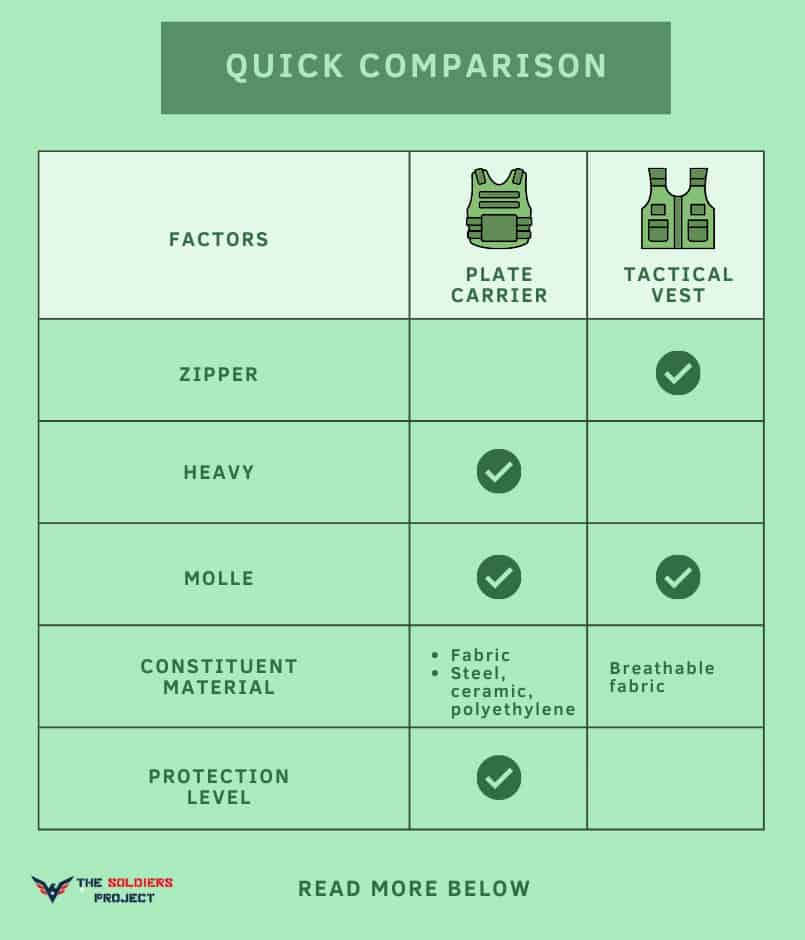Many people interchange the terms plate carriers and tactical vests because they look almost identical. The confusion has reached various forums, like Reddit, so let’s settle the score once and for all. In this article, I’ll try to explore the plate carrier vs vest comparison to see the differences.
Plate carriers are usually heavy and provide excellent bulletproof protection, while tactical vests are lightweight, making them ideal for fast missions. Both of these body armors also differ in several features, such as weight, MOLLE, and material. Let’s understand each armor below.
Table of Contents
What is a Plate Carrier?
As its name implies, a plate carrier carries a plate to stop rifle rounds. These things can be a little heavy on their own, so imagine if you’re going to add more equipment to them. What’s good about these plate carriers is they can ease some of the weight off your gun belt, spreading the weight all over your body.
Military service personnel use these carriers in battle, and police officers use them daily on the street. Oftentimes, these carriers go with conventional bulletproof vest carriers, so you can interchange them with your ballistic panels.
Some agencies provide a different plate carrier for active shooter circumstances to ensure that your ceramic plates are always loaded.
There are several types of plate carriers available. One of them is a concealable plate carrier which allows you to be inconspicuous and be low-key as possible. A Kevlar plate carrier can resist heat and absorb impact. These Kevlar plate carriers can stop a bullet using its elastic nature.
The distinct feature of plate carriers is the generous amount of pouches and MOLLE slots to add essential equipment, like rifle magazines and tasers.
The key to loading your equipment in these spaces is to ensure that they won’t get in the way when you draw your firearm. It’s also crucial to consider the hazards of snagging when adding items to the carrier.
What is a Tactical Vest?
A tactical vest is not only meant for trekking and special weapons and tactics (SWAT) teams anymore. Today, the military has utilized these vests for special duty. More specifically, these vests are used for scouting missions where the military needs to be quick and light.
These tactical vests are usually designed with a zipper on the front for easy wearing and removal. They have MOLLE or pouches to store all necessary items, such as flashlight, knife, and rifle magazines. All the pockets and compartments are attached to the vest securely so they don’t fall off easily.
Flexible tactical vests can be made of various materials and layouts. Others are even designed solely for paintball players, while some wear a front pocket to store the holster on the weak side.
While the tactical vest offers secure storage of your equipment in fast or harmful situations, it lacks the protection that other vest solutions provide.
Plate Carrier vs Vest: What’s The Difference?
- Ease Of Wearing: Tactical vests have zippers, so they’re easier to wear and take off when you’re in a rush. However, these zippers stop you from putting anything in the middle. While plate carriers are more difficult to take off and on, they have adjustable straps and cummerbund to give a more secure fit.
- Weight: Obviously, plate carriers are heavier than tactical vests, but that extra weight means better protection. The ballistic panel found in these carriers can help stop the bullet. On the other hand, tactical vests are more lightweight, making them perfect for missions when you need to be fast.
- MOLLE: Also known as Modular Lightweight Load-Carrying Equipment, MOLLE refers to pouches and compartments to help you carry essential gear for your mission. MOLLE isn’t mandatory for vests, but it’s an essential part of plate carriers. These pouches and compartments can help you carry important stuff, like a first aid kit and rifle magazines.
- Material: Plate carriers are made of ordinary fabric vests with armor plates at the front and back. The armor plate can be steel, ceramic, or polyethylene to provide maximum protection. Vests, on the other hand, don’t have these plates to stop the bullet, but they can be made of breathable fabric material.
- Protection Level: Since plate carriers have thick panels inserted, they provide a higher protection level than ordinary vests. These plate carriers can even protect you from bullets. Also, these carriers can protect you from the heat with their hydration bladders.
Conclusion
In the plate carrier vs vest debate, the choice depends on your preferences and given situation. A plate carrier is perfect if you want something to stop the bullets and provide more MOLLE spaces. A tactical vest is better if you want something more lightweight for fast missions. You also can refer to ways to set up a vest, I think that this is useful for you.
If you have experienced any of these two body armors, let us know in the comments below. Share the article with your friends if you like it.

I am Everett Bledsoe, taking on the responsibility of content producer for The Soldiers Project. My purpose in this project is to give honest reviews on the gear utilized and tested over time. Of course, you cannot go wrong when checking out our package of information and guide, too, as they come from reliable sources and years of experience.




